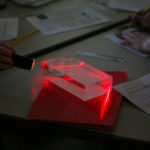-
Color Physics @Hampshire, Day 20
On Day 20, we covered two different topics.
We first discussed how reflection and refraction affect the saturation of pigments.

Reflection and Refraction in pigments from Seeing the Light: Optics in Nature, Photography, Color, Vision, and Holography by David R. Falk, Dieter R. Brill , David G. Stork. Wiley, 1986.
We then moved on to some basic quantum mechanics in order to explain why various pigments absorb and reflect different wavelengths. We used a simple model of atom energy levels of sodium. New concepts introduced included
- Photons and their energy E=hc/λ
- Quantized atomic energy levels
- Energy levels of sodium
- Emission and absorption spectra of gases
Sources: Nassau, Kurt “The Causes of Color,” Scientific American, October 1980, pages 124-154.
-
Color Physics @Hampshire, Day 19
On Day 19 we studied reflection and refraction. Students used light sticks, mirrors, and acrylic blocks to investigate, both qualitatively and quantitatively, the optical behavior of light at the interface of material with different indices of refraction. Their investigations led us to the law of reflection and Snell’s law.*
We introduced a number of new concepts:
- index of refraction
- normal to the surface
- angle of incidence
- angle of reflection
- angle of refraction/transmitted angle
Students sent red LED light through acrylic blocks and investigated its reflection and refraction angles. Students sent red LED light through acrylic blocks and investigated its reflection and refraction angles. *The photgraphs taken by and used with the permission of Andrew Hart of Hampshire College.

